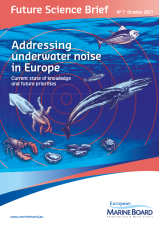
The Ocean presents a cacophony of sounds originating from natural as well as anthropogenic sources. Natural sounds include those generated by a wide range of marine organisms, waves, rain, wind, and seabed movement, while sounds from human activity at sea include shipping and other marine craft, construction and installations, sonar and seismic surveys. Marine organisms heavily rely on sound to communicate and understand the world around them, and are therefore potentially impacted by anthropogenic sound. However, in developing our Blue Economy and in advancing our knowledge of marine environments and ecosystems, anthropogenic noise is sometimes unavoidable.
Underwater noise and its inherent conflicts have been a topic of interest for scientists for a number of years, leading to a significant body of research on the topic. Although significant progress has been made in our understanding of the sources and impact of underwater noise since EMB’s Position Paper N°13 The effects of anthropogenic sound on marine mammals: A draft research strategy published in 2008, knowledge gaps remain. In light of this, Future Science Brief N°7 Addressing underwater noise in Europe: Current state of knowledge and future priorities broadens the scope beyond marine mammals to also include fish an invertebrates, and highlights the outstanding issues that need to be addressed. It presents the state-of-the-art in our understanding of underwater noise, highlighting the progress made since 2008. It then points out the relevant actions that need to be taken in order to ensure that a solid scientific basis is available to inform ecosystem and precautionary-based legislation on underwater noise. This includes in the context of Descriptor 11 of the Marine Strategy Framework Directive, which specifically addresses underwater noise. In developing proportionate mitigation strategies and effective regulation, a detailed understanding of the effects of anthropogenic noise on marine organisms and their ecosystem is of vital importance. The recommendations of the Future Science Brief therefore focus on the critical future research needs.
To download the Future Science Brief, click here. Moreover, you can find a factsheet for its publication here, see the news item about its launch here, and find out more about our work on underwater noise here.
We would like to thank Tony Hawkins for the use of his drawing for Aquatic Noise 2022 (see www.an2022.org) as inspiration for the cover.